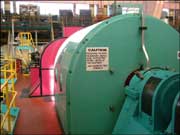9. The Electrical Generator
The Stator
The Stator is stationary and surrounds the rotor.
- It has large coils of wire
- It these coils create voltage and current when a magnetic field "cuts" the wires
- It has a 2 or 4 of magnetic poles. (The number depends on the speed the rotor spins).
The Rotor
The Rotor rotates and is in the centre of the generator.
- It is on a steel shaft that is connected to the spinning turbine
- It has coils of wire in which the magnetic field is created using a DC current.
- It has sliding connections which allow the DC electricity to enter the rotor. These sliding connections are called 'slip rings'
The Stator and the Rotor interact with each other, through the strong magnetic field between them. How they do this is explained by the following two laws.
The Physics of Faraday's Law and Lenz's Law
Faraday's Law and Lenz's Law are two important concepts in electro-magnetism. The generation of electricity is a constant battle between the effects of these laws.
Why does the rotor current have to be increased to get more electricity out?
There are two reasons for this:
- It is the only practical method (Faraday's Law)
- The stator tries to demagnetise the rotor (Lenz's Law).
Faraday’s Law
Faraday's law explains that the output from a generator can be increased by either
- increasing the number of turns of wire
- increasing the strength of the magnetic field, or flux
- spinning the rotor faster
However the only practical way to achieve this at Wairakei is the last case. This is done by the governors on the turbines. Should the rotor slow down, due to increased load on the generators, extra steam is delivered to the turbine to drive the generator harder. This keeps the generator frequency at 50 Hz, the same as the national grid.
Lenz’s Law
This law states that
'The direction of induced current in a coil is such that it opposes the change in the magnetic field that produced it.' |
Lenz's Law explains how the instant the stator coils have electricity induced in them, they too become magnets. The new magnetic poles always oppose or reduce the effect that created them. Effectively Lenz's Law explains how the Rotor tries to demagnetise the Stator any time you increase the Stator's magnetic field.
Keeping the Frequency constant
With Alternating Current electricity the direction the electrons are travelling keeps reversing. This is because a North and then a South Pole go past the rotor coil.
The rate at which a pair of poles goes past is called the
Frequency.
In New Zealand the Frequency is set at 50 times a second (50Hertz, 50Hz).
A lot of effort goes into ensuring that the 50Hz frequency is maintained, to ensure all electrical equipment works correctly.
Frequency Calculation
| A 4-pole generator spinning at 1500 rpm | A 2-pole generator spinning at 3000 rpm | ||||||||||||||||
|
|
NB.
The number of poles is divided by 2, to give the number of magnets
rpm is an abbreviaition for ‘revolutions per minute’
rps is an abbreviaition for ‘revolutions per second’
The Physics of Producing a Perfect Sine Wave
It is important that Alternating Current be as smooth as possible because all transformers, switchgear, motors and household appliances are designed to operate on such a supply. Ideally when graphed (by plotting either the Voltage or Current against Time) this should be a perfect sine wave.
In a simple generator where the poles (magnetic fields) are stationary and the coil is rotated in the field, the waveform is exactly a sine wave. This is because the coil cuts the flux at the sine of the angle, for the coil travelling relative to the direction of the field.
The Importance of Turbine Speed
In New Zealand, the grid has to maintain a frequency between 49.8 and 50.2 Hz. It also has to produce a set number of cycles a day to keep electric clocks running correct. To produce a frequency of 50 Hz and meet the requirements, the turbine speed must be kept near constant.
This is done by
- altering the number of power stations generating and how much is generated from each machine.
- the automatic, instantaneous and continuous control of turbine speed by a governor
- the governor detecting any change in turbine speed, with immediate 'feeds back' so the appropriate adjustment to the steam supply is made. For example, if the grid frequency drops, the steam supply on the turbine opens to try and generate more power. The opposite also happens.
Some factors that affect the load on a day to day basis, and hence frequency are
- The time of day and demand for electricity
- The seasons
- Weather changes
- What other power stations are doing
- The state of the Cook Strait cables
- Damage to the National Grid
The governor systems deal with all instantaneous events. Significant events however are almost always the result of a major tripping, which normally means the North Island generators slow down and the South Island generators speed up.
If power cut occurs over a large area then all the generators have to rapidly reduce their output to keep the frequency correct, in areas that still have power.
It is a constant juggling act, between all the power stations in NZ, to get market share and to keep the frequency at 50Hz.



